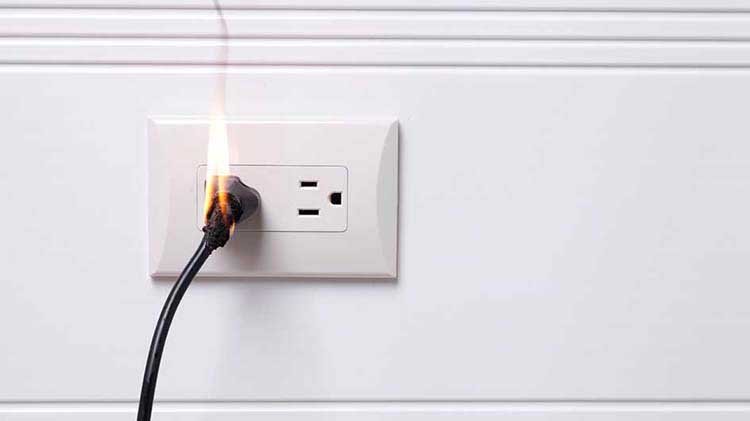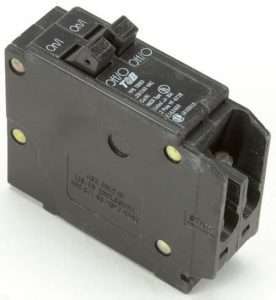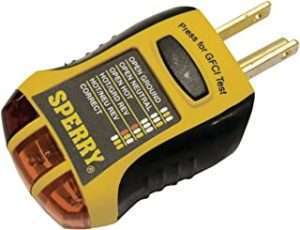Common Home Electrical Problems
Home electrical problems are more common than one might think. In fact, these issues are a part of everyday life for many homeowners. From a flickering light to a circuit breaker that won’t stay on, these problems are annoying and can also be a safety hazard.
However, it’s important to remember that you’re not alone. Millions of homeowners face the same challenges. Being aware of these common issues can help you identify them sooner and take necessary action.
One of the most prevalent electrical issues in homes is circuit breaker problems. This can manifest as a breaker that trips frequently, indicating a potential overload or short circuit.
Another common issue is inconsistent power supply, leading to electricity surges, sags, or dips. These can cause damage to your appliances and disrupt your daily activities.
Understanding these issues and knowing when to call a professional can save you time, money, and headaches. So, let’s delve into these common home electrical problems and how to address them.
Understanding Circuit Breaker Problems
The Role of Circuit Breakers
In every home, circuit breakers play a role in protecting the electrical system from potential hazards. They act as a safety mechanism that automatically shuts off the flow of electricity when it detects an overload or a fault in the circuit. This prevents overheating, electrical fires, and damage to appliances and wiring.
Think of circuit breakers as the guardians of your electrical system. They constantly monitor the current flowing through the circuits and act as a barrier to prevent any mishaps. Without circuit breakers, the electrical system would be at risk of damage and the safety of your home compromised.
Common Causes of Circuit Breaker Tripping
Circuit breakers are designed to trip or switch off when they detect an excessive current flow. This tripping is an essential safety feature that prevents overheating and potential electrical hazards. However, frequent circuit breaker tripping can be a nuisance and a sign of an underlying issue. Here are some common causes of circuit breaker tripping:
- Overloaded Circuits: When you plug in too many devices or appliances into a single circuit, it can overload the circuit and cause the breaker to trip. This is especially common in older homes with limited electrical capacity.
- Short Circuits: A short circuit occurs when a hot wire comes into contact with a neutral wire or a ground wire. This can happen due to damaged insulation or faulty wiring. When a short circuit occurs, the circuit breaker detects the sudden surge of current and immediately shuts off the circuit to prevent damage.
- Ground Faults: Similar to short circuits, ground faults occur when a hot wire comes into contact with a ground wire or a conductive surface, such as a metal pipe or a wet floor. Ground faults can be dangerous as they can lead to electrical shock. Circuit breakers are designed to quickly detect ground faults and interrupt the circuit to prevent any harm.
- Aging Breakers: Over time, circuit breakers can become worn out or damaged, leading to frequent tripping. If your breakers are old or not functioning properly, it is important to have them inspected and replaced if necessary.
Remember, if your circuit breaker is constantly tripping, it is important to address the underlying issue rather than simply resetting the breaker. Ignoring the problem can lead to more serious electrical issues down the line.
Image: Circuit Breaker Panel
Now that you have a better understanding of circuit breaker problems, let’s delve into other common home electrical issues in the next sections. Stay tuned for more valuable information on how to identify and troubleshoot these problems effectively.
Dealing with Electrical Surges, Sags, and Dips
The Impact of Electrical Surges on Appliances
Electrical surges can have a significant impact on your appliances and electronics, causing damage that can be costly to repair or replace. These surges, which involve a sudden increase in electrical current, can occur due to various factors such as lightning strikes or problems with the electrical system in your home. When a surge happens, it can overload your appliances and cause them to malfunction or even stop working altogether.
One of the most common consequences of electrical surges is damage to sensitive electronic components. Devices such as computers, televisions, and gaming consoles are particularly vulnerable to surges. The sudden increase in voltage can fry circuitry and render these devices useless. Not only does this result in a financial loss, but it can also lead to the loss of important data or cherished memories.
To protect your appliances from electrical surges, it is essential to invest in a surge protector. These devices are designed to absorb excess voltage and divert it away from your electronics. When choosing a surge protector, make sure it has a high joule rating and offers surge protection for both electrical outlets and data lines. Consider installing whole-house surge protection to safeguard your entire electrical system.
Identifying the Causes of Electrical Surges
Electrical surges can occur due to a variety of causes, and it’s important to identify and address these issues to prevent future surges. Here are some common causes of electrical surges:
- Lightning Strikes: Lightning carries an immense amount of voltage, and if it strikes near power lines, it can induce a surge in your home’s electrical system. Installing lightning rods and grounding systems can help divert lightning strikes away from your home.
- Faulty Wiring: Poorly installed or outdated wiring can cause electrical surges. Over time, wiring can deteriorate, leading to loose connections or exposed wires that create a risk of surges. It is essential to have a professional electrician inspect your home’s wiring regularly.
- Appliances and Equipment: Power-hungry appliances, such as air conditioners or refrigerators, can cause electrical surges when they cycle on and off. If you notice frequent surges when specific devices are in use, it may be a sign of an electrical issue that needs to be addressed.
- Utility Grid Issues: Problems with the utility grid, such as voltage fluctuations or sudden power restoration after an outage, can also lead to electrical surges. While you may not have control over these external factors, investing in surge protection can mitigate the impact of grid-related surges.
Addressing Electrical Sags and Dips
Electrical sags and dips, also known as voltage fluctuations, can cause various issues in your home. These fluctuations involve a temporary decrease or increase in voltage, which can disrupt the normal functioning of your electrical appliances and equipment. While sags and dips are less severe than surges, they can still lead to damage and inconvenience.
During an electrical sag, the voltage drops below the normal level, causing lights to dim and appliances to operate at a lower capacity. On the other hand, a dip results in a sudden increase in voltage, which can overload devices and cause them to malfunction. These fluctuations can be caused by issues such as faulty transformers, overloaded circuits, or problems with the utility grid.
To address electrical sags and dips, consider installing a voltage regulator or a UPS (Uninterruptible Power Supply) system. These devices stabilize the voltage and provide a consistent power supply to your appliances, protecting them from the negative effects of fluctuations.
In addition to using protective devices, to maintain your electrical system regularly. Have a licensed electrician inspect your wiring, outlets, and circuit breakers to ensure they are in good condition and capable of handling voltage fluctuations.
By understanding the impact of electrical surges, identifying their causes, and addressing sags and dips, you can protect your appliances and maintain a reliable electrical system in your home. Investing in surge protectors, voltage regulators, and professional electrical services will go a long way in safeguarding your electronics and preserving your peace of mind.
For more information on electrical surge protection and home electrical safety, you can visit Electrical Safety Foundation International and Consumer Product Safety Commission.
Troubleshooting Faulty Wiring
Signs of Bad Wiring
When it comes to your home’s electrical system, it’s important to be aware of the signs of bad wiring. Ignoring these signs can lead to serious safety hazards such as electrical fires or electrocution. Some common signs of bad wiring include:
- Frequent Tripping of Circuit Breakers: If your circuit breakers trip frequently, it could be a sign that your electrical system is overloaded or that there is faulty wiring.
- Flickering Lights: Lights that flicker or dim for no apparent reason may indicate loose connections or faulty wiring.
- Burning Smell: A persistent burning smell, especially near electrical outlets or switches, should never be ignored as it could be a sign of overheating wires.
- Hot Outlets or Switch Plates: If your outlets or switch plates feel hot to the touch, it could be an indication of faulty wiring.
- Sparking Outlets: Sparks coming from outlets when plugging in or unplugging devices is a clear sign of bad wiring and should be addressed immediately.
If you notice any of these signs, take them seriously and address the issue promptly to ensure the safety of your home and family.
Common Wiring Problems in Homes
Many older homes are equipped with outdated wiring systems that may not be able to handle the demands of modern electrical appliances and devices. Here are some common wiring problems often found in homes:
- Knob and Tube Wiring: This outdated wiring system, commonly found in homes built before the 1950s, poses significant safety risks due to its lack of grounding and insulation.
- Aluminum Wiring: Homes built in the 1960s and 1970s may have aluminum wiring, which can be problematic due to its tendency to oxidize and cause overheating.
- Overlamping: When a light fixture is equipped with a bulb that has a higher wattage than recommended, it can cause the wires and socket to overheat, increasing the risk of electrical fires.
- Uncovered Junction Boxes: Junction boxes that are left uncovered can expose the electrical connections to accidental damage or contact, posing a risk of electrical shocks or short circuits.
- Improperly Grounded Outlets: Outlets that are not properly grounded can lead to electrical shocks and pose a serious safety hazard.
Hiring a Licensed Electrician for Wiring Inspections
To ensure the safety and functionality of your home’s electrical system, it is highly recommended to hire a licensed electrician for wiring inspections. A professional electrician will thoroughly assess your wiring and identify any potential issues or safety hazards.
During a wiring inspection, the electrician will check for:
- Damaged or frayed insulation on wires
- Corrosion in the service panel
- Code violations or unsafe modifications made by previous owners
Regular inspections every five years can help catch any problems early on and prevent potential hazards. It’s important to note that code violations discovered during inspections may need to be addressed for the safety of your home.
When it comes to electrical safety, it’s always better to be proactive and address any potential issues before they become major problems. Hiring a licensed electrician for wiring inspections will provide you with peace of mind, knowing that your home’s electrical system is safe and up to code.
Remember, electrical work can be dangerous, so always turn off the circuit at the main breaker panel before attempting any repairs or modifications.
Common Home Electrical Problems: Malfunctioning Switches and Outlets
Understanding Switch and Outlet Issues
In every home, switches and outlets power various electronic devices and appliances. However, like any other electrical component, switches and outlets can malfunction over time. Dealing with malfunctioning switches and outlets can be frustrating and potentially dangerous, as they can pose a fire hazard. Therefore, it’s essential to understand the common problems associated with switches and outlets to ensure your home’s electrical system remains safe and functional.
Common Problems with Switches and Outlets
1. Faulty Switches
One common issue with switches is when they stop functioning properly. You may notice that the switch no longer turns the lights on or off as it should, or perhaps it feels loose or wobbly. Such problems can occur due to worn-out internal components or loose wiring connections. If you encounter a faulty switch, it is best to replace it promptly to avoid further complications.
2. Dead Outlets
Have you ever plugged something into an outlet, only to discover that it doesn’t work? Dead outlets are another common problem homeowners face. This issue often occurs due to a tripped circuit breaker or a blown fuse. In some cases, the outlet itself may be faulty or damaged. It’s important to troubleshoot dead outlets carefully, checking the circuit breaker or fuse box before attempting any repairs.
3. Overheating Outlets
Overheating outlets are a serious concern as they can lead to electrical fires. If you notice that an outlet feels hot to the touch or emits a burning smell, take immediate action. Overheating outlets can be caused by loose connections, overloaded circuits, or faulty wiring. To prevent any potential hazards, it is advisable to consult a licensed electrician who can assess the situation and make the necessary repairs.
4. Arcing and Sparking
Arcing and sparking are common problems that occur when there is a faulty electrical connection within the switch or outlet. This issue can lead to flickering lights, intermittent power, or even electrical shocks. Arcing and sparking can be caused by loose wires, damaged insulation, or aging components. It is important to address this issue promptly to prevent any potential electrical hazards.
5. GFCI Tripping
Ground Fault Circuit Interrupter (GFCI) outlets are designed to protect against electrical shock. However, they can sometimes trip, cutting off power to the connected devices. GFCI outlets commonly trip due to ground faults caused by water exposure or faulty appliances. If your GFCI outlet keeps tripping, it may indicate an underlying problem that requires professional attention.
Common Home Electrical Problems: Flickering Lights and Dimming Problems
Causes of Flickering Lights
Flickering lights can be a common issue in many households, but it’s important not to dismiss it as a mere annoyance. While some situations may have easy fixes, others could indicate a more serious electrical problem that requires immediate attention.
Here are a few causes of flickering lights to consider:
- Loose Bulb: If you notice occasional flickering with only one light or when a large appliance kicks in, the culprit might be a loose light bulb. Inconsistent power supply due to loose connections can cause flickering. To fix this, turn off the light, let the bulb cool down, and check if it is screwed in tightly and the right type for the fixture.
- Type of Bulb: The type of bulb you are using can also contribute to flickering. Fluorescent bulbs, for example, tend to flicker when they are warming up.
- Dimmer Switch Bulbs: If you have a dimmer switch, ensure that the light bulb is compatible. LED bulbs, in particular, often flicker when used with non-LED dimmers. Consider using a smart bulb that eliminates the need for a physical dimmer switch.
- Loose Plug Connection: Make sure that the plug is securely plugged into the outlet. If the prongs on the plug are bent, unplug it, straighten the prongs, and plug it back in.
By checking for these simple causes, you may be able to resolve the issue without the need for professional assistance.
Troubleshooting Dimming Issues
Dimming problems can also be frustrating and may indicate underlying electrical issues. Here are a few troubleshooting steps to help you identify and resolve dimming problems:
- Check the Dimmer Switch: If you have a dimmer switch, ensure that it is functioning properly. Sometimes, a faulty dimmer switch can cause lights to dim irregularly. If necessary, consider replacing the switch.
- Evaluate the Bulbs: Dimming problems can also arise from using the wrong type of bulbs. Ensure that the bulbs you are using are compatible with your dimmer switch. LED bulbs, for instance, may require specific dimmers to function optimally.
- Electrical Load: Dimming issues can occur when your electrical system is unable to handle higher loads. If you experience consistent dimming when turning on specific appliances, it could indicate an overloaded circuit. Consider redistributing the electrical load or consulting an electrician to ensure your system can handle the demand.
Conclusion
When it comes to common home electrical problems, it is important to be aware of the potential issues that may arise. Circuit breaker problems, electricity surges, sags, and dips are among the most prevalent issues faced by homeowners. Understanding these problems and their causes in order to maintain a safe and efficient electrical system in your home.
If you experience a circuit breaker that trips frequently, it may indicate a larger electrical problem that requires the attention of a licensed electrician. Additionally, it is important to be mindful of your electricity usage and avoid overloading your circuit breaker with multiple large appliances simultaneously.
Surges, sags, and dips in electrical power can cause significant damage to your appliances and electronics. Using surge protectors can help defend against surge-related damage, but if these issues persist, it is advisable to have an electrician inspect and correct the problem.
By being proactive and addressing these common electrical problems in a timely manner, you can ensure the safety and functionality of your home’s electrical system. Don’t hesitate to seek professional help when needed to avoid potential hazards and inconvenience.











